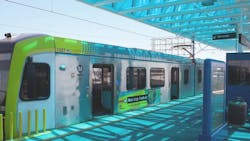L.A. Metro ridership increased for 20th straight month in July
July 2024 marked the 20th consecutive month of year-to-year ridership growth for the Los Angeles County Metropolitan Transportation Authority (L.A. Metro). The agency had 25.5 million boardings in July on its bus and rail services, reaching 81.8 percent of its July 2019 pre-COVID ridership level. The agency saw 19.9 million boardings on weekdays, reaching 78.8 percent of its pre-pandemic July 2019 level. On weekends in July, L.A. Metro says there were 5.6 million boardings, reaching 95.3 percent of pre-pandemic weekend ridership from July 2019.
Bus ridership
According to the agency, bus ridership in July saw 19.7 million rides taken for a 9.84 percent year-over-year ridership increase compared to July 2023 ridership and reached 82.9 percent of its July 2019 level. The agency recorded 15.5 million bus boardings on weekdays in July. Saturdays saw 2.1 million boardings and Sundays had 2.2 million boardings in July. Weekend bus ridership is now at 93.2 percent of its pre-pandemic level.
Rail ridership
In July, the agency says rail boardings were 5.8 million, reflecting a gain of 3.23 percent versus July 2023 ridership and a 78.4 percent recovery of July 2019 rail ridership. Weekday rail boardings were 4.4 million trips taken, reflecting 73.4 percent of weekday rail boardings in July 2019.
L.A. Metro notes that July marked the first full month of year-over-year comparison on the A and E lines and ridership grew 16.8 percent compared to July 2023. Individually, the A Line grew 19.5 percent when compared to ridership in July 2023 and the E Line grew 13.1 percent year-over-year. The busiest rail line in July was the B Line with 1.9 million boardings. The A Line saw 1.9 million trips taken.
Leisure ridership
Leisure travelers rode L.A. Metro to concerts, festivals and sporting events. The agency says July 2024 had more weekday events, which were a driver of overall ridership growth during the month, with weekday bus ridership up 7.4 percent and weekday rail ridership up 2.3 percent. Events at venues with direct L.A. Metro rail access such as Expo Park off the E Line, LA Historic State Park off the A Line and Dodgers Stadium serviced by the Dodger Stadium Express bus from LA Union Station all saw ridership increases.
Fare programs
The agency continues to provide programs that make riding more affordable for everyone. The agency’s reduced-price transit pass programs, such as the student GoPass program, which offers free transit passes to K-12 and community college students, and its Low-Income Fare is Easy (LIFE) program, which provides free rides and reduced fares to low-income customers, are helping those who need it most.
In July, L.A. Metro’s GoPass Program had 479,309 boardings, a 19 percent year-over-year increase compared to July 2023, which saw 395,385 boardings. GoPass also had 21,198 new registrations and renewals combined for a 78 percent year-over-year increase in July enrollment. GoPass has now surpassed 40 million student boardings and more than 400,000 registered students.
LIFE Program enrollment is up 12 percent year-over-year in July 2024, with 1.7 million boardings compared to 1.5 million in July 2023. During July, the LIFE team held more than 75 in-person enrollment events to sign eligible people up for the reduced fare program.
Public safety on L.A. Metro
In July, the L.A. Metro Board of Directors approved a Station Experience package of safety and security upgrades that include:
- A new pilot program that would create taller fare gates at up to three rail stations to deter gate jumping.
- Expansion of the TAP-to-exit program that requires riders to tap fare cards to enter and exit (charged only once) to all 10 end-of-line stations to discourage fare evasion.
- Expansion of the Elevator Open-Door pilot from 21 elevators to 57 elevators, which leaves the doors open until called upon and dissuades non-transit elevator use.
- Expansion of the Smart Restroom pilot from 10 stations to 64 stations and transit centers.
- A new pilot program to test two weapons detection technologies at two transit hubs on the rail system.
The agency continues to increase its work to improve public safety with a three-point plan:
- Keep its employees and customers safe and ensure they feel safe through an increased visible presence of uniformed personnel, station improvements and improved bus safety measures
- Ensure the system is being used only for its intended purpose of transit through fare gate improvements and removal of trespassers
- Continue to partner with the county, the cities and regional agencies to address societal issues such as homelessness, untreated mental illness and drug addiction.
As part of the strategy, L.A. Metro’s law enforcement partners have expanded their visible presence on the rail system and more Transit Security Officers have been added to enforce L.A. Metro’s Customer Code of Conduct rules on both the bus and rail system. L.A. Metro Transit Security Bus Safety Teams performed end-of-line operations during late-night “Owl” service on some of the busiest bus lines. L.A. Metro Ambassadors are also out in force on L.A. Metro’s six rail lines and five of the busiest bus lines to provide support to customers.
